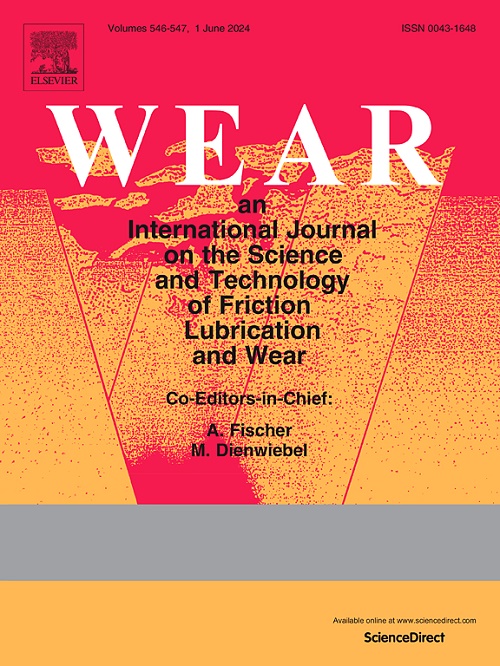干铣 AlCoCrFeNi2.1 共晶高熵合金时刀具磨损和加工质量的变化
IF 5.3
1区 工程技术
Q1 ENGINEERING, MECHANICAL
引用次数: 0
摘要
AlCoCrFeNi2.1 是一种新型共晶高熵合金 (EHEA),由于具有面心立方(FCC)和 B2 相交替的层状结构,因此引起了人们的极大兴趣。高强度和高塑性等特性使这种合金的加工具有挑战性。针对这一问题,我们在干燥条件下进行了铣削实验,以研究 AlCoCrFeNi2.1 EHEA 的加工质量以及刀具磨损情况。通过测量切削温度和切削力来解释刀具磨损和加工质量的变化。明确了刀具磨损机理和演变模式。最后,分析了不同参数下表面粗糙度和表面形貌的变化,并提出了以 B2 相为标志的塑性流动表征方法。结果表明,随着铣削参数的增大,切削温度和切削力都会增加。在材料去除量不变的情况下,刀面磨损宽度随切削速度和进给量的增加而增加。刀具磨损模式随切削参数的不同而变化,例如,当切削速度小于 80 m/min 时,磨料磨损占主导地位,但当切削速度达到 110 m/min 时,则出现粘着磨损和涂层剥落。随着切割速度的进一步提高,除了侧面磨损外,耙面上也开始出现凹坑磨损。磨料磨损和粘着磨损随着进给速度的增加而加剧,直到达到一定的临界值(0.10 毫米/齿),涂层才会从刀具上剥落。此外,当进给量达到 0.14 毫米/齿时,会出现崩刃现象。特别是,刀具附着磨损的形成主要是由 FCC 相附着造成的。在加工质量方面,较大的切削参数会使表面粗糙度和形貌恶化,并导致更深的表面下塑性流动。该研究将有利于促进 AlCoCrFeNi2.1 HEA 的应用。本文章由计算机程序翻译,如有差异,请以英文原文为准。
Evolution of tool wear and machining quality during dry milling of AlCoCrFeNi2.1 eutectic high entropy alloy
AlCoCrFeNi2.1, a new class of eutectic high entropy alloy (EHEA) has drawn significant interest owing to the lamellar structure of alternating face-centered cubic (FCC) and B2 phases. Properties such as high strength and high plasticity render the machining of this alloy challenging. Addressing this issue, the milling experiments were conducted under dry conditions to investigate the machining quality of AlCoCrFeNi2.1 EHEA as well as the tool wear. The cutting temperature and cutting force were measured to explain the changes in tool wear and machining quality. The tool wear mechanisms and evolution modes were clarified. Finally, the change of surface roughness and surface morphology under different parameters were analyzed and the characterization method of plastic flow marked by B2 phase was proposed. Results showed that both the cutting temperature and cutting force increase as the milling parameters become larger. The width of flank wear increases with the increase of the cutting speed and the feed rate when the volume of material removal volume is constant. The tool wear modes evolved differently with different cutting parameters, for instance, abrasive wear dominated while the cutting speed was less than 80 m/min, but for higher speeds up to 110 m/min, adhesive wear and coating peeling occurred. As the cutting speed increases further, crater wear on the rake face starts to arise in addition to the flank wear. Abrasive wear and adhesive wear with increasing feed rate were dominant until a certain threshold (0.10 mm/tooth) beyond which the coating peels off the tool. Furthermore, chipping occurred for a higher feed rate of 0.14 mm/tooth. In particular, the formation of tool adhesive wear is mainly caused by the FCC phase adheres. In terms of machining quality, larger cutting parameters will worsen the surface roughness and morphology as well as lead to deeper subsurface plastic flow. The research will be conducive to promoting the applications of AlCoCrFeNi2.1 HEA.
求助全文
通过发布文献求助,成功后即可免费获取论文全文。
去求助
来源期刊

Wear
工程技术-材料科学:综合
CiteScore
8.80
自引率
8.00%
发文量
280
审稿时长
47 days
期刊介绍:
Wear journal is dedicated to the advancement of basic and applied knowledge concerning the nature of wear of materials. Broadly, topics of interest range from development of fundamental understanding of the mechanisms of wear to innovative solutions to practical engineering problems. Authors of experimental studies are expected to comment on the repeatability of the data, and whenever possible, conduct multiple measurements under similar testing conditions. Further, Wear embraces the highest standards of professional ethics, and the detection of matching content, either in written or graphical form, from other publications by the current authors or by others, may result in rejection.
 求助内容:
求助内容: 应助结果提醒方式:
应助结果提醒方式:


